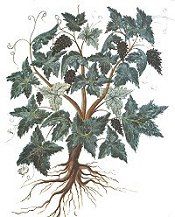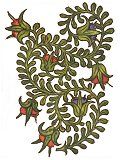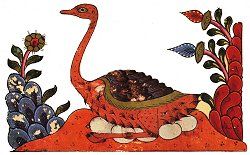Serving the Guest: A Sufi Cookbook
Essays | Recipes | Gallery

On special occasions certain foods take on a symbolic significance. For example, at the Istanbul Qadiri center (called the dergah), on the last Tuesday of Ramadan, seven dishes are served. Soup serves as a reminder of the importance of water to life; meat and vegetables symbolize the earth; pilaf and borek (meat and vegetables rolled in fillo dough) represent fire. Eggs with pastirma — a Turkish cured meat similar to pastrami — signify Divine generative power, combining the feminine symbol of the egg with the salty masculinity of the meat. Gullac, a rose-scented pastry boiled in milk, is an emblem of Divine love.
Special dishes are also prepared for other occasions. First among these is halvah, which appears on every holiday menu. Sutlaç or muhallebia, rice or rice-flour puddings, are served on Mevlid kandili, Muhammad's birthday. Regaib kandili, the anniversary of his conception, is commemorated with a gelatin dessert, pelte, symbolizing the bond between this world and the next. On Mirac Kandili (or Laylat al-Miraj), the night on which Muhammad ascended to the seventh Heaven, red sherbet gelatin is served for dessert, and sherbet and milk are distributed amongst the dervishes. Sherbet and milk were said to have been given to the Prophet by the angels; milk in particular is said to represent Divine blessing and consciousness of God.

One motif of food symbolism is the association of certain colors with happiness and festivity. The three most widely-recurring such colors in Muslim countries are yellow, the color of sunlight, narcissi, and springtime hillsides full of blossoming mustard flowers; green, the sign of birth, regeneration, and Islam; and white, symbolic of brightness, happiness and hope. Yellow rice is an integral part of any festive Indonesian menu, and yellow rice pudding is served on many festive occasions in Iran (where it is called shollehzard) and Pakistan (there called kheer). No-ruz, the Iranian vernal equinox celebration, is always accompanied by foods containing fresh green herbs; families set out pots of growing greens on their windowsills during the season preceding the festival. This holiday is also celebrated in Turkey with similar customs. On Hidirellez, a springtime festival celebrated in Turkey on May 6, it is believed that a walk in a green field, or eating fresh lettuce, onions, green plums or any other green food, will bring a special refreshment and rejuvenation.
The symbolism of white is elaborated in the following story from southeast Anatolia:
Therefore, white foods are eaten during this festival — eggs, milk, yogurt, cheese, rice pudding, stuffed cabbage and pilaf.
from Serving the Guest: A Sufi Cookbook
Copyright © 1999, 2000 by Kathleen Seidel
Sources of previously published material by other authors used by permission, and print sources for images, may be found at http://www.superluminal.com/cookbook.
